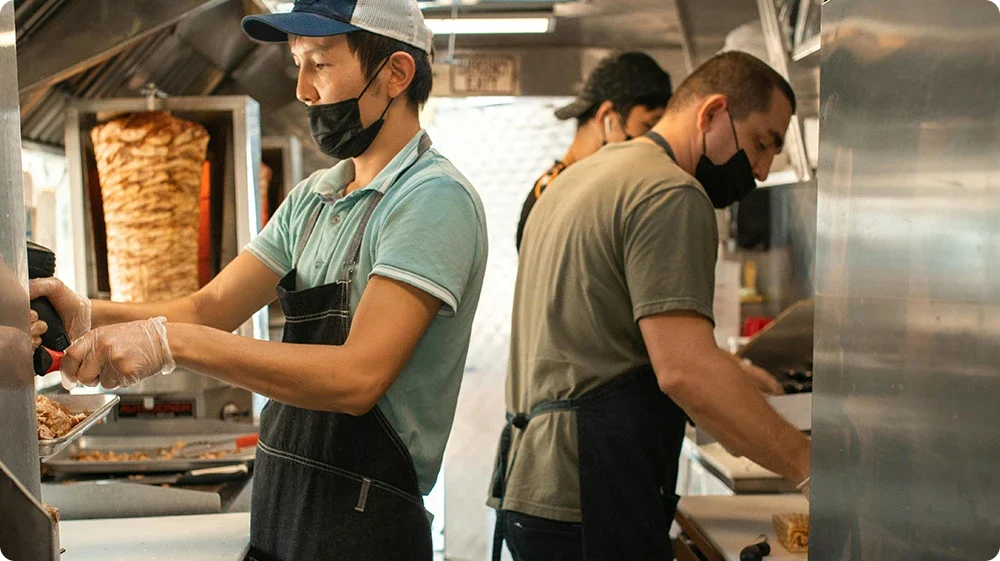
Food handling in busy kitchens, cafés, takeaways, and catering setups is anything but simple. With multiple hands on deck, shared equipment, and fast-paced service, there’s always a risk that something could go wrong, and when it comes to food safety, even one mistake can have serious consequences.
From harmful bacteria and cleaning chemicals to unexpected objects or undeclared allergens, food can become contaminated at any stage, whether it’s during storage, prep, cooking, or serving. These hazards don’t just risk your customer’s health – they can also damage your business reputation and lead to legal trouble.
That’s why it’s crucial to understand what food safety hazards are, how they occur, and how to manage them effectively.
In this article, we’ll break down the four main types of food hazards—biological, chemical, physical, and allergenic — explain their real-world impact, and share practical strategies for keeping your kitchen safe and compliant.

If you're exploring a career in food service or want to make your kitchen safer, don’t miss our guides on Kitchen Hazards and the hospitality and catering industry.
What makes food hazardous?
Food becomes hazardous when it’s contaminated by anything that can cause illness or injury. In a fast-paced kitchen, contamination can come from several sources — some visible, many not.
For example, bacteria such as Salmonella or E. coli can multiply if food is left in the temperature danger zone, where it’s not hot or cold enough to prevent bacterial growth. Even clean-looking food can be unsafe if it’s been left out too long.
Contamination can also occur when allergens like nuts or dairy are accidentally transferred between dishes — a common risk in shared preparation areas. This type of cross-contact can trigger severe allergic reactions, especially when allergenic ingredients aren’t clearly labelled.
Then there are Physical hazards, which are a significant cause of physical contamination in food. These include things like glass shards from broken jars, pieces of plastic from packaging, or even human items like jewellery or fingernails.
Some hazards are harder to detect, like chemical contamination or toxins produced by spoiled food. In cases like food poisoning, symptoms can strike quickly, even when the food smells or tastes fine.
Understanding how these hazards occur is the first step in preventing them, especially in busy kitchens where large volumes of food are prepared every day. Having strong systems in place helps keep both food and customers safe.
Stay Ahead of Food Hazards in Your Industry
Food hazards can occur at any point, whether you’re working in catering, manufacturing, or retail. Maintaining high food hygiene standards isn’t just a best practice, it’s a legal and moral responsibility.
The risks of contamination are real, but with the proper training, they’re entirely preventable.
Ensure that you and your team understand how to handle food safely, minimise risks, and remain compliant with Hurak’s Food Hygiene and Safety Courses.
✅ Level 2 Food Hygiene and Safety for Catering
✅ Level 2 Food Hygiene and Safety for Manufacturing
✅ Level 2 Food Hygiene and Safety for Retail
🧠 CPD Certified | 💻 100% Online | 🕒 Flexible & Self-paced
What are the 4 types of food hazards?
Now that we’ve seen what makes food unsafe, let’s look closely at the four main types of food hazards:
Biological, Chemical, Physical, and Allergenic. Each presents a different risk, but all must be managed effectively to maintain food hygiene and safety.

Biological Hazards in food
Biological hazards are caused by harmful microorganisms such as bacteria, viruses, parasites, and mould. These can lead to foodborne illnesses if not appropriately controlled.
Examples include:
| Type | Example | Common Sources |
| Bacteria | Salmonella, Listeria, E. coli | Undercooked meat, dairy and eggs |
| Viruses | Norovirus, Hepatitis A | Contaminated water, poor hygiene |
| Parasites | Giardia, Cryptosporidium | Contaminated water, raw meat |
| Moulds | Mycotoxins | Cereals, nuts, dried fruits |
Real-life Example:
A chef in a café preps salads on a chopping board that has just been used for raw chicken. Without proper cleaning, bacteria such as E. coli can spread, putting customers at risk.
Health Risks:
Biological hazards can result in vomiting, diarrhoea, listeriosis, or even hospitalisation in vulnerable individuals.
Chemical Hazards in food
Chemical hazards occur when harmful substances contaminate food. This could be due to naturally occurring toxins, accidental residues, or the incorrect use of food additives.
Types of chemical hazards:
a) Naturally occurring toxins
Produced by animals, plants, or microorganisms.
| Toxin Type | Example | Commonly Found In |
| Mycotoxins | Aflatoxins | Peanuts, tree nuts, and corn |
| Marine Toxins | Ciguatera toxin | Fish, shellfish |
| Plant Toxins | Glycoalkaloids | Green potatoes |
| Bacterial Toxins | E. coli O157 toxins | Undercooked beef, unpasteurised milk |
b) Unintentionally added chemicals
These enter food accidentally during farming or processing.
| Source | Example |
| Pesticides and fertilisers | Crops |
| Veterinary drugs | Meat, dairy |
| Cleaning agents | Sanitiser residue on surfaces |
| Environmental pollutants | PCBs, heavy metals |
c) Intentionally added chemicals (in excess)
These are added to improve food quality but can become hazardous if misused.
| Additive | Example |
| Preservatives | Sulphites, nitrates |
| Colourings | Tartrazine, cochineal |
| Vitamins | Excess Vitamin A |
| Polishing agents | On confectionery or tablets |
Real-life Example:
A local food stall uses bleach to clean surfaces but fails to rinse them properly. Chemical residue gets into the food, causing customers to experience nausea.
Health Risks:
Symptoms vary from allergic reactions to organ damage depending on exposure levels.
👉 Learn more about this in our article on microbial contamination
Physical Hazards in food
Physical hazards are objects in food that shouldn’t be there. These could be naturally occurring or accidentally introduced through equipment or packaging errors.
Types of physical hazards:
a) Naturally occurring physical hazards
| Example | Where it might be found |
| Bones | Meat and fish |
| Fruit pits and stems | Cherries, grapes |
| Shells | Nuts, seafood |
| Dirt or soil | Vegetables |
b) Unnatural physical hazards
These enter food due to poor hygiene or faulty equipment.
| Hazard | Source |
| Glass | Broken containers, bulbs |
| Metal | Machinery parts, staples |
| Plastic | Packaging, disposable gloves |
| Human items | Hair, nails, jewellery |
Real-life Example:
A bakery finds shards of plastic from a torn glove inside its dough batch. If unnoticed, this could result in a choking hazard.
Health Risks:
These range from internal injuries and broken teeth to choking and mouth cuts.
👉 Dive deeper into this topic with our physical contamination guide.
Allergenic Hazards in food
Allergenic hazards in food occur when allergens are not correctly declared or separated, putting customers at serious risk, even in trace amounts.
There are 14 allergens recognised by law in the UK:
| Allergens | Common Source |
| Crustaceans | Prawns, crab, pastes |
| Molluscs | Mussels, snails, and sauces |
| Cereals with gluten | Bread, pasta, cakes |
| Soybeans | Soya milk, tofu, and sauces |
| Lupin | Bread, pastries |
| Celery | Soups, sauces, salads |
| Mustard | Curry, salad dressing |
| Sesame | Bread, hummus |
| Sulphur dioxide/sulphites | Wine, dried fruit, processed meats |
| Fish | Dressings, sauces |
| Tree nuts | Almonds, hazelnuts, and ice cream |
| Peanuts | Sauces, cakes, biscuits |
| Milk | Butter, cheese, yoghurt |
| Eggs | Cakes, mayonnaise, and sauces |
Real-life Example:
In a retail food setting, sesame seeds on sandwich bread aren’t mentioned on the label, triggering an allergic reaction in a customer.
Health Risks:
Symptoms include rashes, breathing difficulty, or even anaphylactic shock.
How to control food safety hazards in your kitchen or food business
Understanding food safety hazards is only the first step; controlling them is what truly keeps your customers safe and your business running.
Whether you’re concerned about biological hazards in food, chemical hazards, physical hazards, or allergenic hazards, the goal remains the same: prevent contamination before it happens.
Here are practical ways to do that:
Apply the HACCP Principles
Implementing a structured food safety system, such as HACCP (Hazard Analysis and Critical Control Points), helps you identify risks at every stage—from storage to service.
HACCP is legally required for most UK food businesses and is crucial for complying with regulations such as the Food Safety Act 1990.
Train Your Staff
Ongoing staff training is essential to ensure that everyone understands how to identify and manage food safety hazards in real-time.
Whether you’re a food handler or a manager, training reduces the risk of mistakes and helps you maintain safety standards.
To stay compliant, consider Hurak’s food hygiene and safety courses, such as:
Keep Your Kitchen Clean
A clean kitchen is the foundation of safe food handling. Follow structured processes, such as the 6 stages of cleaning, to remove dirt, reduce microbial growth, and limit the chance of cross-contamination.
Don’t forget to follow Clean as You Go principles during busy service times to maintain hygiene standards throughout the day.
Store Food Properly
Storage mistakes are a common cause of contamination. Ensure:
- Raw meats are kept below ready-to-eat foods in the fridge.
- Foods are labelled with correct use-by dates.
For help setting up your storage system or understanding correct date labelling, check out our guides on:
Separate Allergenic Foods
Prevent cross-contact by using:
- Colour-coded chopping boards
- Separate utensils and storage
- Clear allergen labels
This is especially critical for high-risk foods, such as nuts, milk, and gluten.
Inspect Regularly
Conduct regular checks for signs of physical contamination, spoilage, or pest activity. Look out for:
- Broken packaging
- Cracked equipment
- Signs of Pest Infestation
Use tools like our Food Hygiene Rating Checklist to ensure consistency and compliance with hygiene standards.
Know the Law
Food businesses in the UK must comply with legal frameworks like:
- Food Safety Act 1990
- Regulation (EC) No 852/2004 on the hygiene of foodstuffs
These laws define the legal responsibilities of food handlers and business owners, and breaching them can result in prosecution, fines, or even closure of the establishment.
By taking proactive steps through training, cleaning, proper storage, and allergen management, you can build a culture of food safety in your kitchen.
But good systems alone aren’t enough unless everyone involved understands their specific responsibilities.
Who Is Responsible for Preventing Food Hazards?
Preventing food hazards is a shared responsibility. Everyone involved in handling food has a crucial role to play in keeping it safe, from preparation to serving on the plate.
- Food Handlers must follow proper hygiene, storage, and preparation practices to avoid introducing hazards. They’re on the frontline of food safety.
- Supervisors are responsible for monitoring operations, enforcing safety standards, and ensuring that staff are adequately trained and procedures are followed.
- Business Owners hold the legal duty to implement systems like HACCP, provide regular training, and maintain a hazard-free environment across the business.
Understanding your role helps maintain high standards, avoid penalties, and protect public health.
Conclusion
Food safety hazards, whether biological, chemical, physical, or allergenic, can happen at any time and in any food setting. But with the proper awareness, training, and systems in place, these risks can be effectively controlled.
From organising your fridge and labelling food correctly to implementing HACCP and separating allergens, every step matters. Whether you’re a chef in a restaurant, a team member in food manufacturing, or running a café, being proactive is the key to prevention.
Ready to Strengthen Your Food Safety Standards?
From cafés and takeaways to large-scale manufacturing units, understanding food hazards is just the start.
Take control of food safety across your team with certified training trusted nationwide.
👉 Explore All Food Hygiene & Safety Courses
Find the right course specific to your goals.
✅ CPD Certified | 💻 100% Online | 🕒 Flexible Study Options
FAQs
What are the 4 types of food safety hazards?
The four main types are:
- Biological hazards – such as bacteria, viruses, and parasites.
- Chemical hazards – like cleaning products or pesticides.
- Physical hazards – including glass, metal, or plastic fragments.
- Allergenic hazards – caused by undeclared allergens like nuts, milk, or gluten.
What are biological hazards in food?
Biological hazards refer to microorganisms such as bacteria (e.g., Salmonella), viruses, mould, and parasites that can contaminate food and cause illness. These are often found in raw meat, eggs, dairy, and improperly cooked foods.
What are the physical hazards in food safety?
Physical hazards are foreign objects, such as glass shards, bones, plastic, or metal fragments, that accidentally enter food during preparation, processing, or packaging.
Which food hazard is the most common?
Biological hazards are the most common and can include bacteria like Salmonella or E. coli, which may lead to foodborne illness if food is improperly stored or cooked.
What are allergenic hazards in food?
The presence of allergens such as peanuts, shellfish, milk, or gluten causes allergenic hazards. Even trace amounts can cause serious allergic reactions in sensitive individuals, which is why clear labelling and cross-contact prevention are crucial.
How do I reduce the risk of food safety hazards in my kitchen?
Follow proper hygiene practices, store food correctly, maintain equipment, separate raw and cooked foods, and ensure all staff are trained in food safety procedures.
What’s the difference between cross-contamination and cross-contact?
Cross-contamination refers to the spread of harmful bacteria (like Salmonella) from one surface, food, or person to another, typically involving raw and cooked foods.
Cross-contact, on the other hand, happens when allergens are unintentionally transferred to allergen-free foods, even in trace amounts. This can trigger serious allergic reactions.





